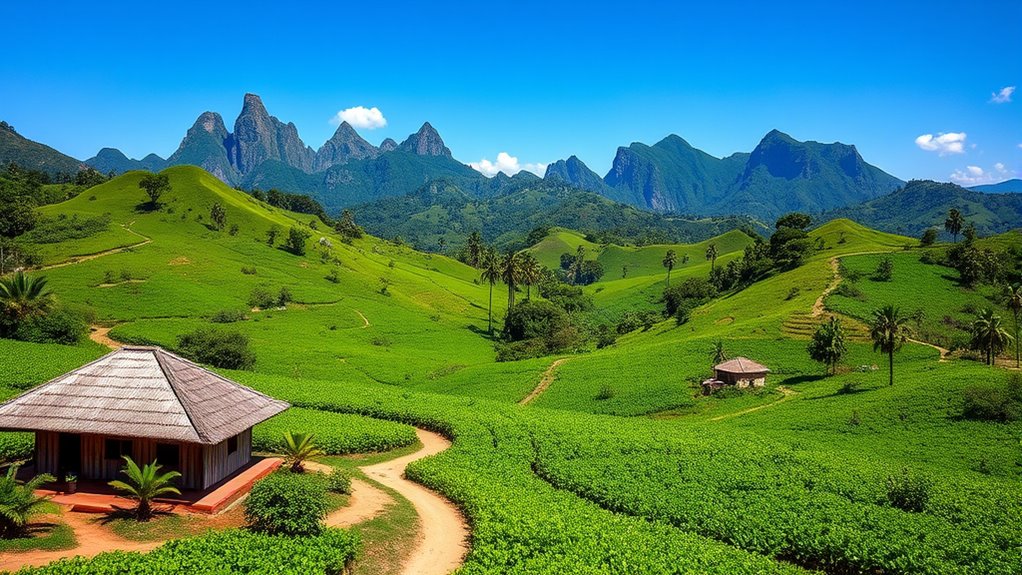In Cuba’s Viñales Valley, agroecology blends traditional farming with innovative practices to protect its unique landscape and cultural heritage. You’ll see farmers using crop diversity, organic techniques, and eco-friendly technologies like solar panels and hydroponics. These practices promote biodiversity, soil health, and ecosystem resilience. Community involvement and traditional knowledge guide sustainable land management. If you explore further, you’ll discover how these efforts help preserve the region’s ecological and cultural identity while inspiring global sustainability models.
Key Takeaways
- Viñales Valley practices traditional farming rooted in indigenous knowledge, emphasizing landscape preservation and cultural heritage.
- Agroecology principles promote biodiversity, crop diversification, and ecological balance to sustain soil health and resilience.
- Farmers integrate organic methods, crop rotation, and renewable energy, combining traditional techniques with innovative eco-friendly technologies.
- Community engagement and storytelling foster knowledge sharing, cultural continuity, and active participation in sustainable practices.
- Key crops like tobacco, bananas, and yuca are cultivated alongside livestock, creating a resilient, ecosystem-friendly agroecosystem.
The Unique Landscape and Cultural Roots of Viñales
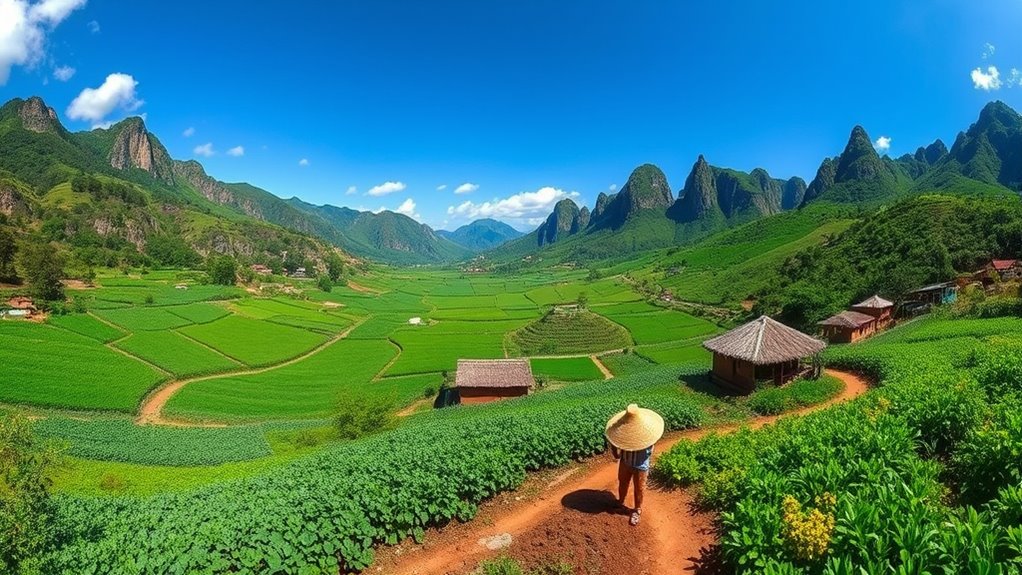
Nestled in the heart of Cuba, Viñales Valley stands out for its breathtaking karst limestone formations called mogotes, which create a striking landscape that has shaped local life for generations. This area’s cultural heritage is deeply rooted in the traditions of its indigenous and rural communities, preserving a way of life intertwined with nature. As you explore, you’ll notice how landscape preservation plays a crucial role in maintaining the valley’s unique scenery and cultural identity. The harmonious relationship between people and their environment reflects a commitment to safeguarding these iconic features. By valuing its cultural roots and protecting the landscape, the community ensures that future generations can continue to experience the beauty and history that make Viñales truly special. Emphasizing sustainable practices helps preserve both the environment and the cultural integrity of the region for years to come.
Traditional Farming Practices and Their Evolution
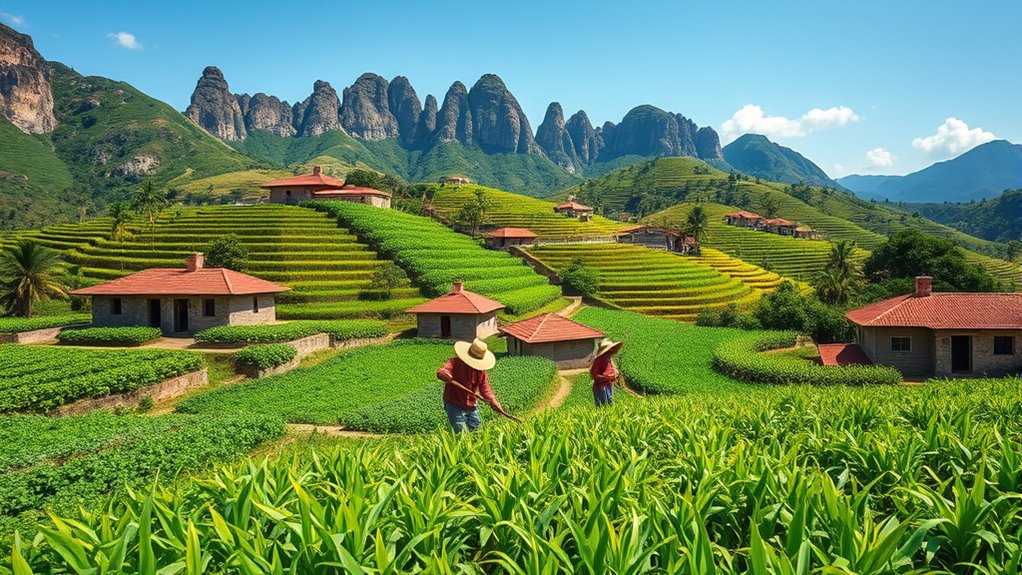
You notice how indigenous crop methods have shaped local farming for generations, yet recent shifts in land use are changing traditional practices. As modern influences arrive, farmers find ways to preserve their ancient knowledge while adapting to new challenges. Understanding this evolution reveals how tradition and innovation coexist in Viñales’ agricultural landscape. Embracing leadership skills such as strategic planning can help farmers navigate these changes effectively.
Indigenous Crop Methods
Traditional farming practices in Viñales Valley have long relied on indigenous crop methods that prioritize harmony with the land. These historical indigenous practices emphasize working with natural cycles and respecting local ecosystems. You’ll notice that cultural crop diversity is a key feature, with farmers cultivating a wide variety of plants suited to the environment. This diversity helps prevent soil erosion, control pests naturally, and maintain soil fertility. Indigenous farmers select seeds carefully, preserving native varieties passed down through generations. Over time, these methods have evolved, blending traditional knowledge with modern techniques, but the core principles remain rooted in respect for nature. Your understanding of these practices reveals a deep connection between the people and their land, shaping sustainable agriculture in Viñales.
Shifts in Land Use
Over time, land use in Viñales Valley has shifted from purely indigenous farming practices to incorporate modern influences, reflecting changing economic and environmental pressures. These shifts involve adopting sustainable methods, driven by policy reform and a focus on land restoration. You’ll notice farmers progressing from slash-and-burn techniques to terracing and organic cultivation, aiming to preserve soil health. Land restoration efforts help prevent erosion and maintain productivity amid urbanization. Policy reforms support these changes by incentivizing eco-friendly practices and protecting natural landscapes. The table below illustrates the evolving land use approaches:
| Practice | Purpose | Impact |
|---|---|---|
| Traditional farming | Subsistence | Land degradation |
| Modern terracing | Soil conservation | Increased productivity |
| Organic cultivation | Environmental health | Biodiversity preservation |
| Land restoration | Ecosystem balance | Long-term sustainability |
| Policy reform | Sustainable development | Enhanced land management |
Additionally, incorporating erosion control measures is crucial for maintaining soil integrity as land use practices evolve.
Traditional Knowledge Preservation
Although modern practices have transformed land use in Viñales Valley, farmers continue to uphold and adapt their traditional knowledge to maintain cultural identity and ecological balance. You can see this through:
- Preserving indigenous storytelling, which passes down farming techniques and ecological wisdom across generations.
- Participating actively in cultural festivals that celebrate farming heritage and emphasize sustainable practices.
- Adapting traditional methods, like crop rotation and organic fertilization, to modern challenges while respecting ancestral customs.
- Incorporating environmental conservation principles into their farming routines to ensure the long-term health of the land and local ecosystems.
These practices guarantee that age-old knowledge remains relevant, fostering resilience and ecological harmony. Farmers see their traditions not just as history but as essential tools for sustainable agriculture. This ongoing preservation keeps the community rooted in its cultural and environmental identity.
Principles of Agroecology in the Region
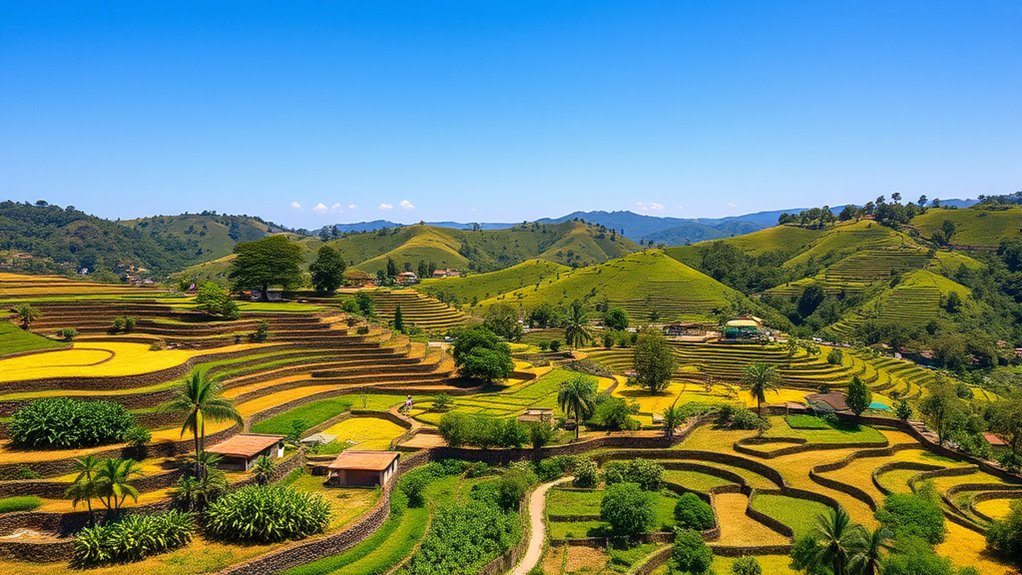
You’ll see how preserving biodiversity supports resilient ecosystems and healthy soils in Viñales. Traditional farming practices play a key role in maintaining this balance by fostering diverse crops and natural pest control. Together, these principles create a sustainable approach that respects the region’s unique environment. Incorporating agroecological practices such as crop rotation and organic fertilizers further enhances soil health and ecosystem stability.
Biodiversity Preservation Strategies
Biodiversity preservation stands at the core of agroecological practices in Viñales Valley, where farmers actively implement strategies that protect native species and maintain ecological balance. You can support these efforts by focusing on three key approaches:
- Creating habitat corridors that connect fragmented ecosystems, allowing native species to thrive and migrate safely.
- Promoting diverse planting practices that attract and sustain native species, ensuring food sources and shelter.
- Limiting chemical use to prevent harm to native flora and fauna, fostering a healthy environment for all species.
- Incorporating data-driven marketing strategies to raise awareness and promote sustainable practices among local communities and visitors.
These strategies help preserve the region’s unique biodiversity, ensuring the resilience of local ecosystems. By prioritizing native species and habitat corridors, you contribute to a sustainable and balanced agroecological landscape that benefits both farming and nature.
Traditional Farming Practices
Traditional farming practices in Viñales Valley are rooted in a deep understanding of the land and its natural rhythms, emphasizing harmony with local ecosystems. You rely on methods like modern irrigation to optimize water use without disrupting the environment, ensuring crops receive adequate moisture. Organic pest control is central to maintaining healthy soil and plant life, avoiding harmful chemicals and supporting biodiversity. These practices reflect a respect for nature’s balance, encouraging natural fertilization and crop rotation to sustain soil fertility. By integrating traditional techniques with simple technologies, you preserve the landscape’s ecological integrity. This approach not only sustains local communities but also reinforces the region’s commitment to agroecology principles, fostering resilient and productive farming systems that coexist peacefully with the surrounding environment. Incorporating practices such as diverse cropping systems and color accuracy further enhances sustainability and productivity.
Key Crops and Livestock in Sustainable Farming Systems
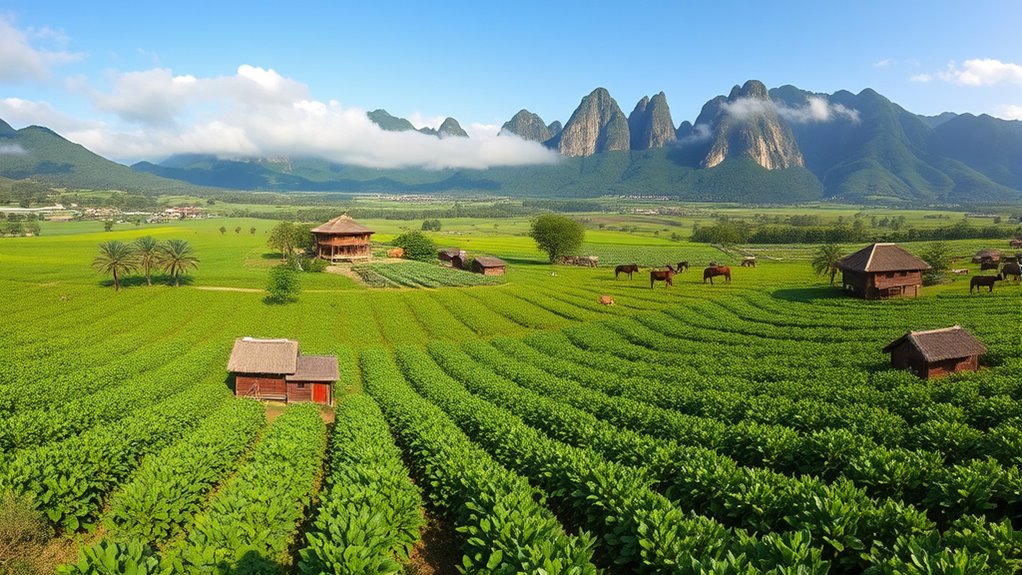
What are the cornerstone crops and livestock that sustain sustainable farming in Viñales Valley? You’ll find that crop diversification and livestock integration play crucial roles. The key crops include:
- Tobacco, which remains central to local culture and economy.
- Fruits like bananas and plantains, supporting diet diversity.
- Vegetables such as yuca and peppers, promoting soil health and variety.
Livestock, mainly chickens and pigs, integrates into farming systems by providing manure for compost and reducing waste. This synergy enhances soil fertility naturally while minimizing external inputs. Crop diversification ensures resilience against pests and climate fluctuations, maintaining productivity. Livestock offers additional income and nutritional benefits, reinforcing sustainability. Incorporating innovative farming techniques can further optimize these practices for better environmental and economic outcomes. Together, these elements create a balanced, eco-friendly farming system rooted in traditional practices but adapted for modern sustainability.
Community Engagement and Local Knowledge Sharing
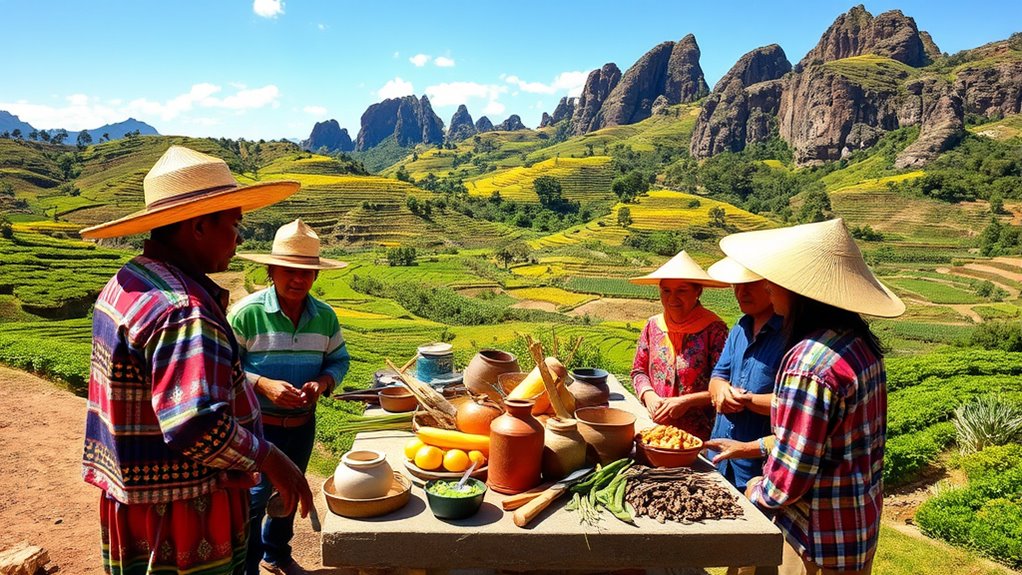
In Viñales Valley, the success of sustainable farming heavily relies on strong community engagement and the sharing of local knowledge. You play a crucial role in building community resilience through active participation and storytelling. When farmers share experiences, they preserve valuable insights that adapt practices to local conditions. This collective knowledge fosters trust and cooperation, essential for maintaining ecological balance. Local storytelling keeps traditions alive and strengthens bonds among farmers, ensuring everyone learns from each other. To illustrate, consider this table:
| Community Role | Knowledge Sharing Method | Impact |
|---|---|---|
| Farmers | Group discussions | Preserves traditions |
| Elders | Oral storytelling | Transmits experience |
| Youth | Participatory events | Reinforces resilience |
| Local leaders | Workshops and meetings | Enhances cooperation |
Your engagement ensures the community thrives and sustains their environment. Knowledge sharing plays a vital role in adapting practices to local conditions and fostering resilience.
Innovative Techniques and Eco-Friendly Technologies
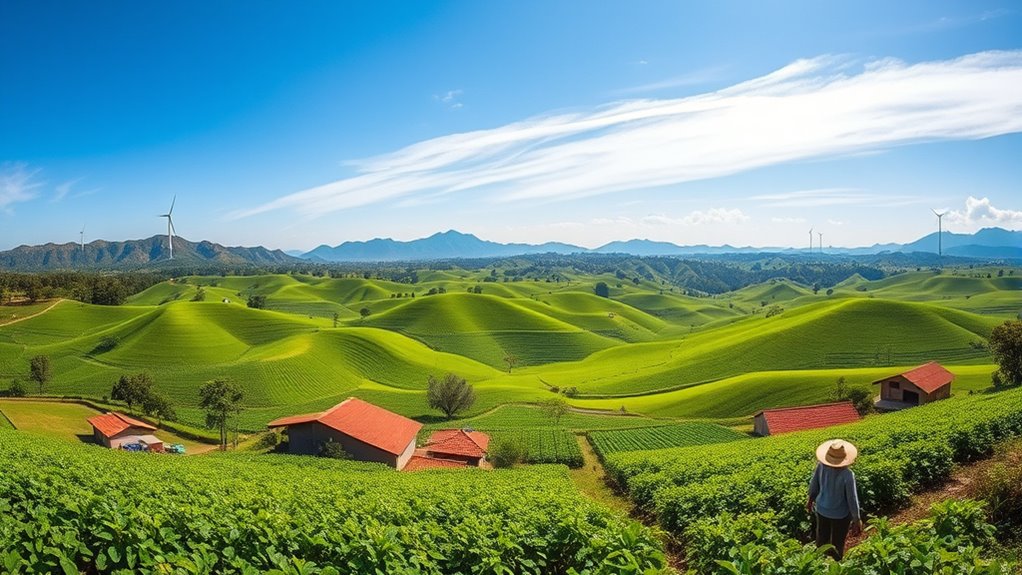
Introducing innovative techniques and eco-friendly technologies can considerably enhance sustainable farming in Viñales Valley. You can adopt several methods to boost productivity and reduce environmental impact. First, hydroponic innovations allow you to cultivate crops without soil, conserving water and space. Second, integrating renewable energy sources, like solar panels, reduces dependency on fossil fuels and lowers carbon emissions. Third, using organic composting techniques improves soil health naturally, minimizing chemical use. Additionally, implementing proper storage practices for fertilizers and tools helps maintain equipment and prevents contamination. These approaches help maintain the valley’s delicate ecosystem while increasing yields. By combining hydroponic systems with renewable energy, you create a more resilient and sustainable farming model. Embracing these technologies not only preserves Viñales’ natural beauty but also ensures long-term agricultural viability for future generations.
Challenges and Opportunities for Scaling Agroecology
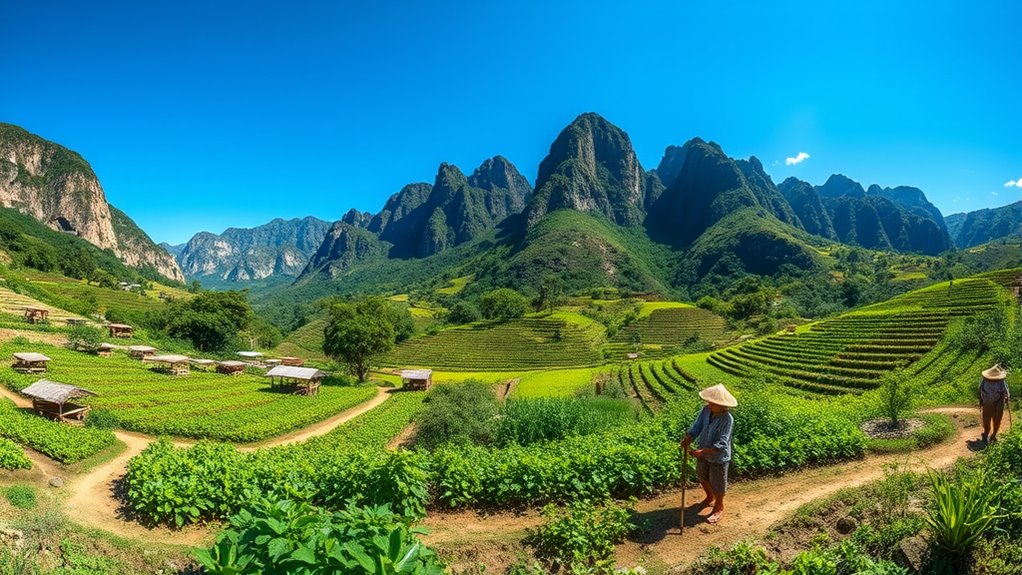
Scaling agroecology in Viñales Valley presents both significant hurdles and promising opportunities. One major challenge is limited market access, which restricts farmers’ ability to sell their produce at fair prices and discourages broader adoption. Additionally, policy support remains inconsistent; while some government initiatives promote sustainable practices, others lack clear incentives or infrastructure. However, opportunities exist through increasing awareness of agroecology’s benefits and strengthening local networks. Improving policy frameworks can encourage farmers to transition fully, while developing local markets and cooperatives can expand market access. With targeted support, training, and incentives, you can help overcome these barriers, fostering a resilient, sustainable agricultural system that benefits both farmers and the environment.
Impact on Biodiversity and Ecosystem Health
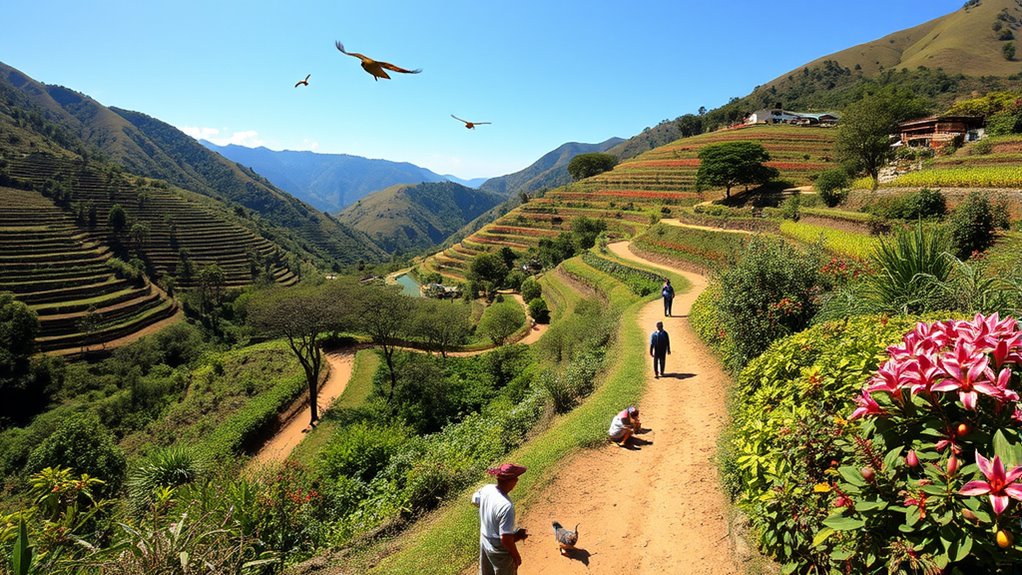
Adopting agroecological practices in Viñales Valley directly benefits biodiversity and ecosystem health by promoting diverse crop varieties, preserving native species, and reducing chemical inputs. This approach enhances pollinator health, as native plants provide essential nectar and habitat, supporting bees and other pollinators. Additionally, it increases soil carbon sequestration, improving soil fertility and resilience. Specifically, you can expect:
- A richer variety of native plants and wildlife, strengthening ecosystem balance.
- Better pollinator populations, ensuring effective pollination for crops and wild plants.
- Improved soil health through higher organic matter, reducing erosion and enhancing productivity.
Lessons From Viñales for Global Sustainable Agriculture

The successful implementation of agroecological practices in Viñales offers valuable lessons that can inform sustainable agriculture worldwide. You can see how integrating local communities and promoting ecological methods boosts socioeconomic impacts, providing livelihoods beyond traditional farming. This approach fosters resilience and reduces dependency on chemical inputs, which benefits both farmers and ecosystems. Additionally, tourism influence in Viñales highlights how sustainable practices attract visitors, generating income while preserving the environment. By emphasizing agroecology’s social and economic benefits, Viñales demonstrates that sustainable agriculture isn’t just about environmental health but also about empowering local populations. These lessons show that adopting eco-friendly, community-centered models can create a balanced, resilient, and prosperous agricultural system globally.
Frequently Asked Questions
How Does Climate Change Affect Viñales’ Agroecological Practices?
Climate change challenges your agroecological practices by making weather patterns unpredictable, which impacts crop resilience. You must prioritize climate adaptation strategies to protect your crops from droughts, floods, and pests. By adopting resilient crop varieties and sustainable practices, you can improve your farm’s ability to withstand these changes. This proactive approach helps maintain productivity and preserves the ecological balance in your land, ensuring your farming remains sustainable in a changing climate.
What Role Do Women Play in Local Sustainable Farming Initiatives?
In many communities, gender roles often shape how sustainable farming unfolds, with women quietly nurturing change. Your involvement in local initiatives highlights women’s empowerment, as they lead efforts to promote eco-friendly practices and community wellbeing. By participating actively, you help challenge traditional boundaries, fostering a more inclusive approach to sustainable farming. Your role is crucial, inspiring others and demonstrating how women’s leadership drives positive environmental and social transformation.
How Is Youth Engagement Promoted in Viñales’ Agricultural Communities?
You see that youth engagement in Viñales’ agricultural communities is actively promoted through youth-led innovations and educational outreach programs. Young people are encouraged to develop new sustainable practices and share knowledge, fostering a sense of ownership and responsibility. These initiatives inspire the next generation to participate in agroecology, ensuring the community’s resilience and environmental health. Your involvement helps sustain local traditions while embracing innovative, eco-friendly farming methods.
Are There Any Certification Programs for Eco-Friendly Products From Viñales?
Imagine a badge of honor on a product—that’s what eco labeling initiatives and organic certification programs do. In Viñales, you’ll find several eco-friendly products bearing certification that guarantees sustainable practices. These programs promote environmental responsibility and help consumers make informed choices. By supporting these certified products, you actively contribute to preserving the valley’s natural beauty and promote agroecology, making your choices impactful and meaningful.
How Does Tourism Influence Local Agroecological Efforts and Resource Management?
Tourism greatly impacts local agroecological efforts by promoting cultural preservation and boosting local employment. When visitors appreciate eco-friendly practices, they support sustainable farms and conservation efforts, encouraging farmers to maintain traditional methods. This influx of tourism revenue fosters community engagement in resource management, ensuring that natural resources are conserved for future generations. Your participation as a responsible traveler helps sustain these initiatives, strengthening both the environment and local livelihoods.
Conclusion
By embracing agroecology in Viñales, you see how blending traditional wisdom with innovative practices can restore biodiversity and foster sustainable livelihoods. For instance, imagine a nearby community adopting crop diversification and eco-friendly tech, leading to healthier soils and resilient farms. This approach showcases that, with shared knowledge and commitment, you can transform agriculture into a force for ecological balance and social well-being—proving Viñales’s model holds valuable lessons for global sustainability efforts.

